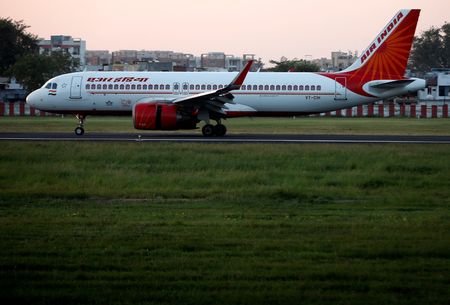By Allison Lampert and Aditi Shah
PARIS/DELHI (Reuters) -Indian aerospace suppliers see record jet orders by the country’s top two carriers boosting domestic parts manufacturing and aircraft repairs, but argue the government must do more to support production.
Rising traffic, a search for alternative sourcing to China and orders this month from Air India and IndiGo for nearly 1,000 jets combined have made India a key market for aerospace.
Now, small and medium suppliers want to capitalize on that to drive more sales of locally sourced parts, they told Reuters on the sidelines of the Paris Airshow last week.
“Today we are going to be the largest purchaser of planes in the world,” said Shekhar Sardessai, managing director at Kineco Group, a supplier in the western state of Goa, referring to India.
“We deserve a piece of that pie,” added Sardessai, whose company makes engine and plane interior parts.
While French engine maker Safran has plans for an engine repair and overhaul facility in India, about 90% of the country’s aircraft maintenance and repair activity occurs outside its borders, according to consultancy Deloitte.
The Indian repair and overhaul industry is expected to grow to $4 billion by 2031, up from $1.7 billion in 2021, Deloitte said.
India’s civil aviation ministry expects the orders to boost aerospace manufacturing in the country, but it cannot mandate local production since the orders do not have requirements for local production like defense deals, a senior government official told Reuters.
Deloitte India partner Alaric Diniz expects parts of the commercial aviation supply chain to move to India as plane and engine makers look to avoid disruptions seen in recent years. While he could not estimate how much small suppliers will benefit, any subsidy or incentive could be helpful.
AEROSPACE INCENTIVES
Some suppliers like Sardessai and Aravind Melligeri, CEO of aerospace-parts producer Aequs, said India should create a production-linked incentive scheme for aerospace as it has done with other sectors.
In 2020, Indian Prime Minister Narendra Modi’s government launched a program to encourage companies in 14 sectors including autos to manufacture locally by earmarking 1.97 trillion rupees ($24 billion) in incentives. It has drawn investment from the likes of Foxconn, which supplies to iPhone maker Apple, and automakers including Japan’s Suzuki Motor and South Korea’s Hyundai Motor have committed to put in money.
Even without incentives, India’s growing fleet of aircraft will require more maintenance services.
“If you will have that many planes in India who repairs them?” said Sachin Agarwal, chairman of PTC Industries, based in the state of Uttar Pradesh. “Every supplier wants to be closer to the customer.”
PTC is already taking advantage of global supply-chain demand for alternate sources to Russian-made titanium and Chinese production.
It expects to increase production from 1,500 metric tons of titanium alloy at the end of 2023 to 6,500 metric tons in 2025. PTC is separately expanding capacity of titanium and superalloy castings tenfold by 2025.
“The objective is to set up the capability in India which was missing,” Agarwal said.
Since Safran’s 2022 announcement, Sardessai has seen an increase in supply enquiries.
The fact that more engines are going to be sold in India drives up the volume of repairs and maintenance which can benefit the local supply chain, said Ankit Patel, director of Ankit Fasteners, which supplies screws and bolts to General Electric, Airbus and Boeing from Bengaluru in southern India.
Patel said French suppliers now want to partner with him to gain access to India, a reversal from the years he pursued inroads in Europe.
Melligeri of Aequs wants to be sure demand for Indian-made parts and components will persist once of the buzz of the Paris Airshow fades, after companies like his invest in new capacity.
“I don’t want them to come and go,” he said, referring to interest in India.
($1 = 81.9830 Indian rupees)
(Reporting by Allison Lampert in Paris and Aditi Shah in DelhiEditing by Ben Klayman and Matthew Lewis)








